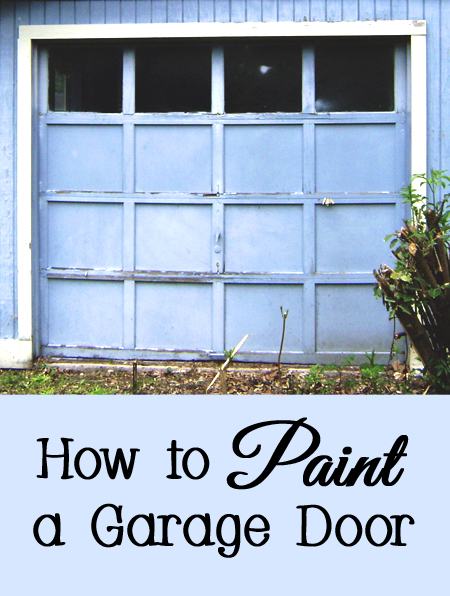Whether your garage door needs a fresh coat of paint in the same color it is currently, or you want to change the color for an updated look, painting a garage door is a beginner to intermediate level DIY project that most homeowners can complete in one day or one weekend.
Whether your door is wood, steel, or aluminum, follow these DIY steps below for painting your garage door.
 photo courtesy of Patrick Feller flickr.com/photos/nakrnsm/3448036347/Check the Weather
photo courtesy of Patrick Feller flickr.com/photos/nakrnsm/3448036347/Check the Weather
Before deciding to paint your garage door, make sure to check the weather.
You should paint your garage door on a day when the weather is not too hot or too cold (ideally 60 to 75 degrees Fahrenheit).
It should not be windy since wind can blow dust and dirt into the wet paint.
There should be low humidity since paint dries slower on humid days.
There should also not be rain in the forecast for the day you are painting and the day after you paint.
Make sure to get all of your paint and supplies before the day you begin painting so you can start the project in the morning and have plenty of time to finish before it gets dark outside.
Clean
Using soap and water and/or a pressure washer (be careful that the pressure is not too strong to damage your door), clean your garage door well.
Make sure to remove all dirt, dust, leaves, mud, spider webs, wasp nests, bugs, and other things that collect on garage doors.
Sand
Scrape any peeling, cracking, or flaking paint off of your garage door, but check for lead paint first.
If you have any rust on your garage door, make sure to repair the rust before proceeding.
Sand down your entire garage door using a power sander or you can sand by hand.
If you are getting new garage door hardware (such as carriage door hardware), remove the existing hardware and fill in any holes that are no longer needed, then sand the filler smoothe once dry.
After sanding, wipe down the garage door with a tack cloth to remove all of the sanding dust.
You may want to rinse the sanding dust off with a garden hose.
If you get the garage door wet, ensure it is fully dry before proceeding.
Wiping it down with a dry towel will help ensure that it is dry and get any extra dirt, debris, and dust that you may have missed.
Tape Off
Tape off areas that are near your garage door that you do not want painted, such as garage door windows.
If you want to spray paint your garage door, make sure to use plastic sheeting around the garage door and on the driveway in front of the garage door so you don't get paint over spray on those areas.
If you are rolling and brushing on the paint, tape off any area close to the garage door that you do not want painted.
Consider opening the garage door slightly, putting cardboard underneath, and closing the door on the cardboard to catch any drips that may occur.
Prime
Using an exterior grade primer, paint all of the garage door surfaces lightly.
If you are changing the paint color from dark to light or from light to dark, you may need two coats of primer.
Allow the primer to dry per the paint manufacturer's instructions before proceeding.
Paint
Using a high quality exterior paint, paint all of the garage door surfaces using two or more thin coats of paint.
Several thin coats of paint work better than one thick coat of paint that takes longer to dry and has a tendency to drip.
Remove any painter's tape prior to the paint being fully dry for easiest removal.
Drying Time
Allow the garage door to dry per the drying time listed in the paint manufacturer's instructions.
Do not touch or open the garage door until the paint is fully dry.
Once it is fully dry, you can reinstall your garage door hardware.
If any paint gets on your garage windows, you can remove it using a razor blade.

